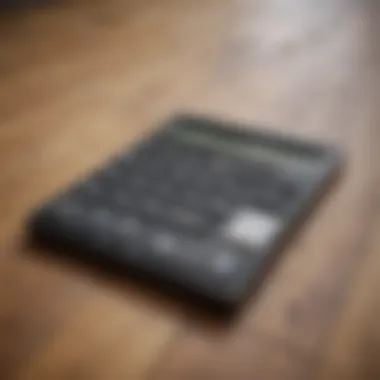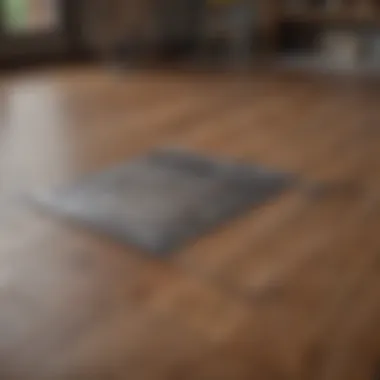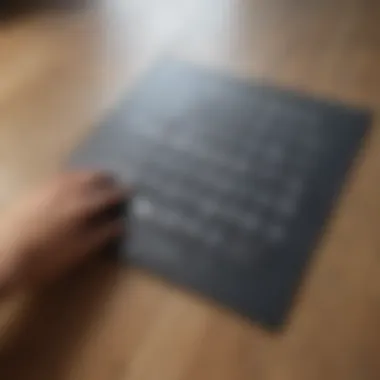Mastering Square Feet Calculators for Flooring Projects


Intro
When it comes to flooring, measuring the area accurately is crucial for any successful installation. Enter the square feet calculator, a handy tool that takes the guesswork out of flooring projects. Whether you are a seasoned interior designer, a homeowner embarking on a new renovation, or simply someone interested in optimizing living spaces, understanding how to use these calculators can save both time and money.
Square feet calculators are essential not just for determining how much material you'll need, but also for gauging costs and minimizing waste. In an age where home improvement shows flood our screens, practical knowledge on flooring measurements can empower individuals to bring their visions to life with confidence.
This guide explores the pivotal role square feet calculators play in flooring projects, from functionality to challenges. We’ll also dive into the innovative materials available and how they can transform your space, making it both beautiful and functional.
Get ready to roll up your sleeves and make informed decisions as we unravel the details surrounding flooring calculations!
Prolusion to Square Feet Calculators
Square feet calculators are not just handy tools; they serve as critical assets in the realm of flooring projects. In the fragmented world of home improvement, having a reliable means to measure can be the difference between a successful renovation and an ongoing headache. Understanding how these calculators function allows homeowners, contractors, and design enthusiasts alike to tailor their projects with precision and accountability.
Understanding the Basics of Area Measurement
To grasp the full potential of square feet calculators, one must first dive into the principles of area measurement. Essentially, area defines the two-dimensional space a surface covers. For flooring, this translates to knowing the length and width of the room or area where flooring will be laid down. However, area measurement is often not as straightforward as it seems. The most commonly used formula for a rectangle is simply length multiplied by width. But when you encounter rooms that veer away from perfect geometry—think of oddly shaped living areas or alcoves—calculating area can become rather intricate.
It's vital to remember that units matter. Square feet is a commonly accepted metric in the United States, while other regions may rely on square meters. Awareness of these differences can prevent costly mistakes during your project. Notably, when measuring in square feet, it’s crucial to convert all measurements to feet. A room that's 10 feet by 12 feet easily translates to 120 square feet of flooring required.
Significance of Accurate Measurements in Flooring
When you’re dealing with flooring, accuracy in measurement can’t be stressed enough. Whether it’s choosing hardwood, tile, or carpet, even the smallest errors could throw a wrench into your plans, resulting in purchasing too much or too little material. The repercussions? Wasted resources, irregular layouts, or mismatched designs.
Having an imprecise measurement might also lead to difficulty in installation. Imagine buying the perfect tiles for your kitchen but then realizing that the actual area is 15 square feet larger than you thought. Besides disappointment, you will face extra costs and the hassle of returning products or making emergency trips to the store.
An added layer of complexity comes when you consider underlayment, waste factors, or unique architectural features such as pillars or built-ins. All of these elements call for meticulous attention to detail in measurement.
In a nutshell, accurate flooring measurements are not only about getting numbers right; they pave the way for a seamless, aesthetically pleasing installation. With square feet calculators at your disposal, navigating these challenges can become a manageable endeavor.
Types of Flooring and Their Measurement Requirements
Understanding the different types of flooring and their unique measurement requirements is crucial for anyone involved in renovation or construction. Each flooring material has its nuances, and accurately measuring the area needed can lead to better budgeting, fewer mistakes, and a smoother installation process. This section will highlight why being mindful of these specific requirements matters, addressing potential pitfalls and considerations you shouldn't overlook.
Hardwood Flooring Calculations
Hardwood flooring is often revered for its durability and aesthetic appeal. When measuring for hardwood, you need to consider the dimensions of the room along with the type of planks you intend to use. Generally, hardwood planks come in various widths and lengths which will influence your overall calculations.
Start with measuring the width and length of the room. Multiply these numbers to get the total square footage. However, it’s wise to add an extra 10% to account for wastage due to cuts, mistakes, or the occasional imperfect plank.
For instance, let’s say your room measures 12 feet by 15 feet:
[ Area = Length \times Width = 12 \text ft \times 15 \text ft = 180 \text sq ft ]
Adding 10% for waste: 180 sq ft + 18 sq ft = 198 sq ft. Always round up when ordering materials to ensure you don't find yourself short.
Tile Flooring Measurements
Tile flooring offers variances in design and strength, each requiring thoughtful measurements. The first step is to determine the room’s area similarly to hardwood by noting length and width. However, unlike hardwood, many tiles come in standardized shapes and sizes, complicating the calculation slightly.
Tiles are usually sold by the box, covering a specific area. For example, if one box covers 20 square feet, and you need 300 square feet:


- Calculate total needed: 300 sq ft \div 20 sq ft/box = 15 boxes.
Don’t forget to consider grout lines, which can change the overall look and feel of the installation. Also, a surplus of around 15% should be included for breakage and future repairs.
Carpet and Laminate Area Calculation
Carpet and laminate flooring share a crucial aspect: they are often easier to install than other flooring types. When measuring for carpet, the first step is similar: measure the length and width of the room. Carpet rolls typically cover large areas but vary by style.
To find total carpet needed:
- Measure the length and the width of the room.
- Multiply the two to find square footage.
- Then, adding an additional 10% is always a smart move.
For laminate, calculations follow a similar route. However, since laminate comes in planks like hardwood, let’s say you need to calculate for a room that measures 10 by 12 feet:
[ Area = 10 \text ft \times 12 \text ft = 120 \text sq ft ]
With a 10% buffer added, that leads you to about 132 sq ft total. Accurately accounting for every corner, nook, and cranny ensures a better fit and minimizes waste.
Key Takeaway: Measuring your flooring accurately can save both time and money. Each type of flooring material invites different considerations and methods, so being precise is vital.
Using a Square Feet Calculator Effectively
Using a square feet calculator effectively is a cornerstone of a successful flooring project. These tools are not just calculators; they serve as a roadmap to achieving your flooring goals without unnecessary hiccups. A thoughtfully inputted measurement allows homeowners and designers alike to estimate material needs accurately, preventing costly overages or shortages. This section delves into the pivotal aspects of maximizing these calculators' potential.
Step-by-Step Guide to Input Measurements
When it comes to inputting measurements into a square feet calculator, precision is paramount. Follow these steps:
- Gather Your Tools: Ensure you have a tape measure, pencil, and paper handy. Noting down measurements helps prevent any mix-up.
- Measure Lengt and Wdith: For rectangular or square rooms, measure the length and width. If the room has built-in fixtures or alcoves, make sure to account for those in your calculations.
- Note All Dimensions: Write down every measurement carefully. If your room isn’t a perfect square or rectangle, take note of different sections, and be sure to not overlook corners or unusual shapes.
- Input in Calculator: Now, take your jotting and input the numbers into the square feet calculator. Most calculators will ask for length and width, but others might ask for additional factors like ceiling height, which can be crucial for material choices.
- Double Check Your Entries: Always double-check entries to avoid simple yet costly errors.
By following these steps diligently, you’ll pave the way for accurate results.
Reading and Interpreting Results
Once measurements are entered, interpreting the results is the next logical leap. The outputs can vary based on the type of square feet calculator used, but generally, here are key components you should focus on:
- Calculated Area: This figure gives you the total square footage of your flooring project, which is essential for determining how much material you need to purchase.
- Material Estimate: Some advanced calculators can provide an estimation based on your area calculation—offering a more integrated approach to your material needs like how many tiles or boards to buy, accommodating for standard sizes and packages.
- Overage Recommendations: A competent calculator will often recommend buying extra material, typically around 10% of your total estimate, to account for waste or future repairs. This is something to really pay attention to because it can save you headaches down the line.
Understanding these calculators is much like reading a map; improper interpretation can lead to detours.
Whether you are a seasoned flooring enthusiast or a first-time renovator, knowing the ins and outs of these calculators will lead not just to success but confidence in your decisions.
Calculating Flooring Area: Practical Examples
When it comes to flooring projects, the ability to accurately calculate the area is not just a best practice; it’s essential. Understanding how to apply practical examples in calculating flooring area assures that you will cut costs, time, and material waste. Utilizing square feet calculators becomes not only a time-saver but a safeguard against headaches later on in your renovation or installation process. These examples make abstract numbers concrete.
Example Calculation for Rectangular Rooms
Calculating the area of a rectangular room is as straightforward as pie, but it’s a cakewalk that tends to trip up many. Start by measuring the length and width of the room in feet. Let’s say your room is 12 feet long and 10 feet wide. The area is calculated by multiplying these two dimensions:
Area = Length × Width
Area = 12 feet × 10 feet = 120 square feet
Now, if you're thinking about flooring options, understanding that you’ll need the materials measured out to cover 120 square feet is crucial.


But let’s not forget that calculating the areas of rectangular rooms often requires attention to detail. For instance, if there are any nooks or fitted furniture to consider, it may bump your measurement around. Make sure to measure from wall to wall, accounting for any bulky pieces.
Handling Irregularly Shaped Spaces
Dealing with irregularly shaped spaces can feel like navigating a maze without a map. However, breaking down the area into smaller manageable shapes can facilitate the task significantly. Take a room that forms an ‘L’ shape. Instead of tackling the whole area at once, split it into two rectangles.
- Measure each section independently:
- Calculate the area for each rectangle:
- Add together the areas:
- First rectangle: 6 feet by 4 feet.
- Second rectangle: 8 feet by 10 feet.
- First rectangle area: 6 feet × 4 feet = 24 square feet.
- Second rectangle area: 8 feet × 10 feet = 80 square feet.
- 24 square feet + 80 square feet = 104 square feet
Breaking spaces down into smaller rectangles simplifies complex calculations and minimizes errors.
It’s worth noting that irregular spaces often come with additional obstacles—like built-in bookshelves or fireplaces—that can further complicate your calculations. Consider sketching a basic floor plan on paper; this layout can then help visualize how to segment the area for your flooring calculations.
Mastering these foundational concepts will elevate your expertise in flooring projects, enabling you to save resources while achieving a polished result. Engaging with these practical examples prepares you to confront the curveballs that your unique spaces might throw your way.
Common Challenges in Flooring Calculations
Flooring projects come with their unique set of hurdles, and understanding these challenges can make or break your endeavor. A square feet calculator is a handy tool, yet it can't always foresee the twists and turns in a room's layout or the quirks of different flooring materials. Here, we dive into what you need to watch out for, with a focus on tackling two significant challenges: dealing with fixtures and architectural features, and accounting for waste and overages.
Dealing with Fixtures and Architectural Features
When measuring the space for flooring, fixtures like cabinets, columns, and doorways can throw a wrench in the works. These architectural features change the way you calculate the area, leading to inaccuracies if ignored.
Imagine you're measuring a living room that has an awkwardly placed column. You might take measurements as if the space was completely open, but that won't reflect reality. To ensure precision, consider the following steps:
- Identify all fixtures: Go through your space and note everything from built-in furniture to radiators.
- Adjust your measurements: Take the space that each fixture occupies out of your total area. In other words, subtract that area from your measurements.
- Use software or calculator features: Many modern calculators allow for adjustments based on fixtures, helping you visualize how to measure around them.
As you work on these calculations, think of fixtures as puzzles to be completed rather than hurdles to bypass. Every adjustment you make can lead to a better overall fit.
Overlooking these elements can result in buying more materials than you need or, on the flip side, not enough, creating a recipe for frustration.
Account for Waste and Overages
In the world of flooring, waste is often an inevitable part of the process. Even skilled contractors may miscalculate, and it's common to end up with material that goes unused. This waste can come from several sources:
- Cuts and Waste: You'll likely need to cut tiles or boards to fit into your space, and not all cuts will be perfect. Allowing for a bit of extra material can save you headaches later.
- Mistakes: Mistakes happen, whether it’s a miscalculation or damaged materials. Building in a buffer is a wise move.
- Future Repairs: Having extra materials on hand for future repairs can be invaluable. If a tile breaks or a board gets scratched, you'll want to match it exactly.
To account for these potential oversights, it’s generally recommended to add 10-15% to your final measurements. Doing so gives you a cushion, ensuring you’re not caught off guard when the unexpected occurs.
In summary, while using a square feet calculator significantly simplifies the flooring measurement process, being aware of these common challenges can help you navigate the intricacies successfully. Take the time to factor in fixtures and account for waste, and you'll find yourself better positioned for a smooth and satisfying flooring project.
Advanced Features of Modern Flooring Calculators
The landscape of flooring calculators has evolved significantly, moving beyond basic calculations to embrace advanced technological functionalities. These tools are becoming quintessential for homeowners, designers, and contractors seeking more accurate and efficient flooring project management. Leveraging such features can ensure that not only the square footage is calculated but that all entailed subtleties are handled with precision.
Integration with Design Software
Integrating square feet calculators with design software is a game changer. It allows for seamless incorporation of measurements into visual plans. Imagine working on a software like SketchUp or AutoCAD, where you can immediately see how a flooring choice will fit into your overall design. When you adjust the calculations in the flooring calculator, you can see those changes reflected in real-time.


This kind of integration provides several advantages:
- Real-time adjustments: Don't waste time recalculating; see the effects of your changes immediately.
- Enhanced visualizations: A clearer view of how flooring interacts with other elements in a room helps in making informed decisions.
- Collaborative work: Designers can easily share their models with clients or team members, making discussions more productive.
It's essential to choose flooring calculators that can easily sync with your design software of choice. Look for options that have API compatibility or those that allow for easy exports to various file formats.
Mobile Applications for On-the-Go Calculations
With the world constantly on the move, having a square feet calculator on your smartphone is invaluable. Mobile applications offer the flexibility of calculating measurements right from the job site, without needing a computer or pen and paper. This helps in keeping projects fluid and adaptable.
Consider the following features that make mobile apps beneficial for flooring calculations:
- User-friendly interfaces: Most apps prioritize simplicity, allowing quick input and fetching of results.
- Offline capabilities: Don't let lack of internet connection hold you back. Many apps allow for functionality without Wi-Fi.
- Storage for repeat projects: Save common room dimensions for easy access in future projects, speeding up the calculation process.
- Networking features: Some apps even let you share results with team members or clients directly from the app, enhancing communication.
As you select a mobile flooring calculator, pay attention to user reviews and software support. A highly rated app will ensure a smoother experience.
"In the fast-paced realm of home design, every second counts. A good flooring calculator saves not just time, but also the headaches that come from miscalculations."
Selecting the Right Calculator for Your Needs
Selecting the right square feet calculator is a crucial step for any flooring project, whether you're a homeowner, a contractor, or an interior designer. With the market flooded with numerous options, it can be a bit overwhelming to figure out which tool will serve your particular needs best. In this section, we will explore the essential elements to consider when choosing a calculator, as well as the benefits that come with making an informed decision.
When it comes to flooring, just any old calculator simply won’t do. You’ll want one that is designed explicitly for the task at hand. A specialized calculator ensures that you're not just guessing measurements, but using accurate metrics to get the job done right. Accuracy is key, as even the tiniest miscalculation can lead to unnecessary expenses and time lost due to rework.
Features to Look For
When selecting a square feet calculator, pay attention to the following features:
- User-Friendly Interface: A calculator that is intuitive and easy to navigate helps reduce errors in inputting measurements.
- Customization Options: Look for a tool that allows you to account for different shapes and sizes of rooms. Some calculators let you input irregular spaces, which is essential when dealing with complex layouts.
- Conversion Capabilities: Many flooring calculations require conversions between units such as square feet, square yards, or square meters. A good calculator should manage these conversions effortlessly without requiring you to double-check your math.
- Material Calculator: Some calculators will consider specific materials you are using. For instance, wood flooring may require a different amount of material than tile or carpet. This can help you estimate how much waste to expect.
- Built-In Memory Functions: A feature that saves previously entered data can save time if measurements need to be redone or adjusted.
Cost vs. Functionality Analysis
As with many things, there's often a trade-off between cost and functionality in flooring calculators. Generally speaking, the more expensive models tend to come packed with advanced features, but it is essential to evaluate what you truly need.
- Evaluate Your Frequency of Use: If flooring calculations are a regular part of your business, investing in a high-quality calculator may save you time and money in the long run.
- Basic vs. Advanced Functions: If your needs are fairly basic, such as calculating square footage for straightforward rooms, a less expensive, simplified calculator might meet your needs perfectly. However, if you often deal with irregular shapes and complex materials, it may be wise to opt for a more sophisticated model.
- Warranties and Support: Sometimes spending a bit more grants you a warranty or customer support which can be crucial. Good support can alleviate headaches if you encounter issues using the calculator later.
With so many choices available, carefully assessing your specific needs will help ensure you invest in a calculator that not only fits your budget but also enhances your efficiency in flooring projects. Take your time to weigh the features you require against how much you're willing to spend, and the right choice will soon present itself.
Culmination and Final Thoughts
As we wrap up our exploration of square feet calculators for flooring, it’s essential to recognize their pivotal role in any flooring project. These tools not only streamline measurements, but they also enhance overall project efficiency, ensuring that homeowners and contractors make informed decisions based on precise data.
The significance of accurate measurements cannot be overstated. Inaccuracies can lead to unnecessary costs, wastage, and even project delays. Thus, having the right calculator tailored to one’s specific needs is crucial. Whether it’s for a cozy living room or a sprawling commercial space, an appropriate square feet calculator can simplify the process.
Moreover, practical application of what’s learned throughout this article can elevate any flooring project from a simple task to an art form. Understanding every aspect of measurement, the common pitfalls, and the advanced features can empower users, leading to both satisfaction and successful outcomes.
“A good measurement is half the battle won.”
Recap of Key Points
- Understanding Area Measurement: Knowing how to accurately assess area is foundational for any flooring project.
- Types of Flooring: Different materials like hardwood, tile, or carpet all come with specific measurement needs.
- Effective Use of Calculators: Step-by-step approaches to inputting measurements and interpreting the data ensure successful outcomes.
- Common Challenges: Recognizing and addressing issues such as fixtures and waste can mitigate costly mistakes.
- Advanced Features: Leveraging modern tools that integrate into design software or mobile applications can provide a competitive edge in project management.
Encouragement for Practical Use
As you embark on your flooring journey, don’t shy away from applying the knowledge gleaned from this guide. Take time to familiarize yourself with the features of the calculators available. Whether it’s for a major renovation or a small update, using these tools can make a difference as you plan your space.
Practical application solidifies understanding. So, roll up your sleeves and calculate! Remember, the more you practice measuring and using the square feet calculators, the more adept you will become at navigating the complexities involved.
As you move forward, embrace the learning process. Each project is an opportunity to refine your skills and broaden your knowledge. Happy measuring!







